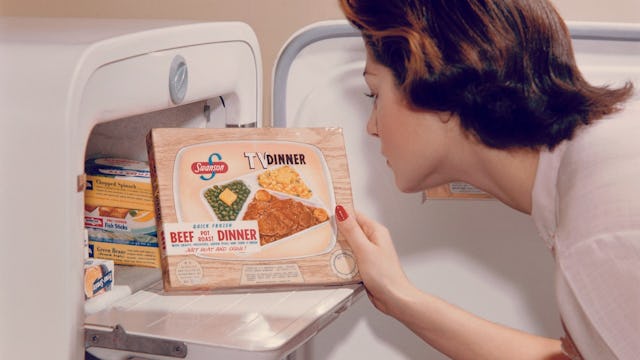I Was Raised On Processed Food, And These Are My Favorites

‘Tis the season not just for food, but food nostalgia. Waiting my turn at the office microwave the other day, I heard one co-worker describe her mom’s sweet potato pie, eyes shining as she was transported back to family gatherings of yore. That got someone else talking about his mom’s soul-warming chicken and dumplings, and how he and his siblings used to help roll out the dough.
I made appreciative yummy noises in the right places. But I felt left out of the club, as I always do when people talk about their mom’s cooking. Not because I didn’t have a mother — I had the world’s best. But what she cooked us never seemed worth talking about.
I was raised on that most unromantic of comestibles: processed food. My favorite childhood dishes were mass-produced and trademarked; my memories of them have accompanying jingles. With ingredients sourced from labs, they were located only somewhere on the food spectrum. Our family recipes — found on the backs of boxes or inside labels — were the opposite of secret.
And yet, when I think about our factory-to-table dishes, I become as nostalgic as any other former child. I remember:
Midnight-black early evenings during a Midwestern winter, rolled-up towels underlining windows and doors to block the cold, my mom ladling Campbell’s Chunky Beef Stew over plates of Minute Rice. The wet-paper taste of the rice brought out the briny richness of the gravy, like our kitchen made cozier by the frigid blankness outside.
Searching among the lumpy Jell-O salads and Corningware for my mom’s go-to church potluck dish: Idahoan scalloped potatoes. Starchy slivers with sauce so pleasingly browned on top that there must be a French word for it. I would fill half my plate, taking advantage of the freedom-in-a-crowd one finds at potlucks and in big cities to load up the other half with desserts.
Coming home from elementary school at lunchtime, The Price Is Right on TV, my sister and I yelling dollar amounts to Bob Barker while my mom flipped gooey grilled cheese sandwiches made with Velveeta. My mom always let me do the best part of sandwich prep — using a thread to cut Velveeta slices from the upright orange brick.
It was the late 1970s, the apex of the processed food trend. My mom was just not that into cooking. Of course she wanted us to be well-nourished, but in those days, a meal was healthy if it included something — anything — from each of the four food groups. With Tuna Helper and a side of canned green beans, our bases were covered.
And so, meal after meal, my mom worked with a line of well-known sous chefs to feed her family: Mrs. Grass assisted with her chicken noodle soup, Chef Boyardee prepared her beef ravioli, and Betty Crocker assembled the ingredients for her cakes.
One day I came home after a rough day in sixth grade craving my usual snack of Golden Grahams. I opened the pantry to see a strange albino package on our cereal shelf, devoid of markings except for the red block letters describing its content: Ready-to-Eat Corn Flakes. It looked like it had been imported from the Soviet Union. It heralded doom.
Slowly, the beloved brand names on our shelves started to disappear, replaced by drab substitutes: Artificially Flavored Vanilla Ice Cream, Cream-Style Corn. The Generics had arrived, draining our cupboards of color and my life of a little joy.
This huge step downward in our culinary fortunes happened about the same time my dad’s unemployment benefits ran out, with no new source of income on the horizon. This situation made the generic foods all the more offensive. Like the oversized block of government cheese in our fridge, the generics had an unappetizing whiff of poverty.
“But it’s exactly the same food,” my mom tried to convince me. “They’re cheaper only because they save money on packaging.”
My science fair project that year was conceived to prove her wrong. I chose three generic products — boxed macaroni and cheese, canned peas, and vanilla sandwich cookies — and compared them to their brand name counterparts and a mid-priced store brand. The experimental design was rigorous. I came up with objective quality metrics. The number of shriveled peas. The thickness in millimeters of the cream filling. I employed my siblings as independent raters in blind taste tests. The generics came in last every time. I showed my mom the results in a glorious, I-told-you-so moment, but there was not much victory in my Q.E.D. She told me I did a nice job and offered to help me make my poster. And kept buying the cheapest versions.
Eventually, family fortunes picked up and the generic brands lost popularity everywhere. Cheerful name brands returned to my life, and it would be many years before I realized that there was nothing so great about them after all: They were the product of a widely denigrated era in American culinary culture. My friends who came from posher or more interesting cultural backgrounds did not eat them, and besides, they were bad for you.
Now, like the other parents I know, I try to limit the processed foods I feed my own kids. But also like other parents, I have the impulse to share with my offspring the things that made me happy when I was a child. And to pass on as much as I can of my mother, who sadly is no longer with us. And that’s why, this holiday season, in addition to free-range turkey and soup made from organic butternut squash, we had Pillsbury Sugar Cookies and Stove Top stuffing. This winter, I also plan to make Mock Wild Rice with Campbell’s French Onion Soup, which, I will tell the children, is “your Grandma’s special recipe.”